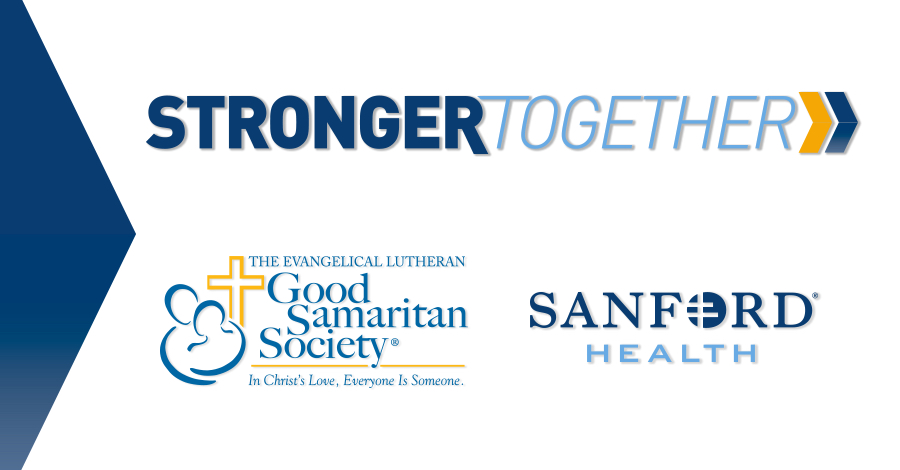
The merger of one of the country’s largest senior living and care organizations with one of the country’s largest healthcare systems will have a “ripple effect” throughout the sector, Lisa McCracken, senior vice president of senior living research and development for specialty bank Ziegler, told McKnight’s Senior Living.
The 96-year-old Evangelical Good Samaritan Society, the second-largest not-for-profit senior living provider organization in the country, according to the 2017 LeadingAge Ziegler 150 list, announced Tuesday that its membership had “overwhelmingly” voted to revise the organization’s articles of incorporation, clearing the way for an affiliation agreement with Sanford Health to be signed.
|
Numbers The Evangelical Lutheran Good Samaritan Society has 19,000 employees in 24 states. Total units/beds: 17,839, according to the LeadingAge Ziegler 150. It has annual revenues of more than $200 million, according to the LZ 150. Sanford Health has 28,000 employees. The system includes 44 hospitals and almost 300 clinics in nine states and four countries. |
Sanford President and CEO Kelby Krabbenhoft predicted that the organizations’ plan “will become a national model to serve communities with exceptional care and value through the full spectrum of one’s life.”
Each organization’s governing board previously had approved the affiliation. With the membership vote over, the regulatory review process can begin. Members primarily are current executives and location administrators and executive directors/managers, although several former employees also are members.
“Our membership affirms what we believed at the onset of our discussions with Sanford,” Good Samaritan Society President and CEO David J. Horazdovsky said in a statement. “By bringing the expertise of the professionals at the Society together with the healthcare experts at Sanford, not only will there be benefits for those we serve but also the organizations are stronger together.”
The entities, both headquartered in Sioux Falls, SD, hope to combine by Jan. 1, Good Samaritan said. The resulting organization will be known as the Good Samaritan Society of Sanford Health.
As McKnight’s Senior Living previously reported, Good Samaritan and Sanford first announced that they were exploring a possible merger in November. “Both organizations have a history of working together to create integrated healthcare delivery and providing specific services to seniors,” Horazdovsky said at the time. “This exploration is a natural progression in how two industry leaders will address the significant challenges in meeting the needs of those we serve.”
In a January update to employees, Horazdovsky described discussions up to that point as having been “both positive and productive.”
Good Samaritan has “a strong commitment to nursing care and is clearly exposed to the significant pressures in the dynamic healthcare environment. Partnering with a health system makes sense in that regard,” McCracken said. “A merger of this size in senior living also demonstrates that affiliations are not only taking place among smaller organizations,” she added.
A senior living provider organization merging with a health system presents an “interesting dynamic,” McCracken said.
“With the exception of many of the large Catholic-sponsored health systems and a few others — for instance, the University of Pittsburgh Medical Center — most health systems are not entering the senior living or seniors housing market,” she noted.
Good Samaritan and Sanford already operate a joint venture together called Prospera, first announced in July 2016, that involves five senior living communities in North Dakota. Aaron Woods, Good Samaritan’s director of corporate communications, told McKnight’s Senior Living that that relationship is not expected to change.
“In some ways, it’s a microcosm of how the combined enterprise will function,” he said.
It’s too soon to say exactly how Sanford’s three senior living communities in South Dakota and its affordable seniors housing property in Minnesota will operate after the agreement becomes effective, Woods said. The affiliation, however, “represents an opportunity to provide the efficient delivery of care across the lifespan for the people we serve,” he said.
The combined organization’s size and scale also should result in more affordable care and the sharing of best practices, Woods said.
McCracken said she’s interested in what the future holds for independent living under the new entity. “In addition to ELGSS providing skilled nursing and assisted living services, there are more than 5,000 independent living units under their sponsorship,” she noted.
Good Samaritan ranks No. 3 in size among U.S. not-for-profit senior living organizations in terms of independent living units, according to the 2017 LZ 150, which is based on data that were current as of Dec. 31, 2016. The organization has 5,131 independent living units.
Good Samaritan is tops in size in terms of both assisted living units (2,274) and nursing home beds (10,434), according to the list. It is No. 10 in terms of affordable housing units, with 1,494 units across 46 communities.
McCracken and LeadingAge CEO Katie Smith Sloan predicted potential success for the affiliation.
“Overall, knowing the pressures facing healthcare and senior living in general, we [Ziegler] think where affiliations and mergers make strategic sense, it is a good thing for the sector,” McCracken said. “Given the bench strength of each of these organizations, we anticipate great things will come out of this merger.”
Sloan told McKnight’s Senior Living that she praised the effort to create a new organization with “the organizational strength and breadth to care for individuals throughout their lifetime.”
“Our country’s approach to the delivery and funding of healthcare is under tremendous pressure at the same time as our population is rapidly aging,” she said. “Innovation is necessary to address the significant challenges faced by our members in providing care for older adults.”
More affiliations and mergers in the sector could be coming, McCracken said.
“There are very strategic reasons to consider an affiliation or merger similar to ELGSS,” she said. “We know of a number of other not-for-profit, multi-site senior living organizations who are in discussions with one another.”



